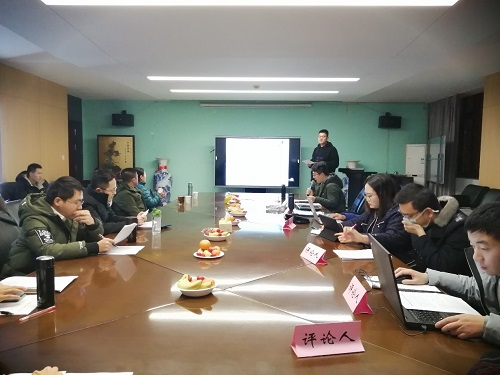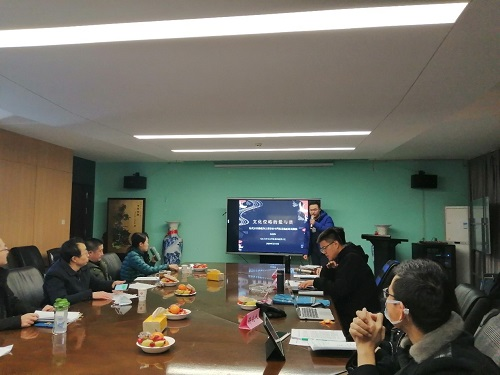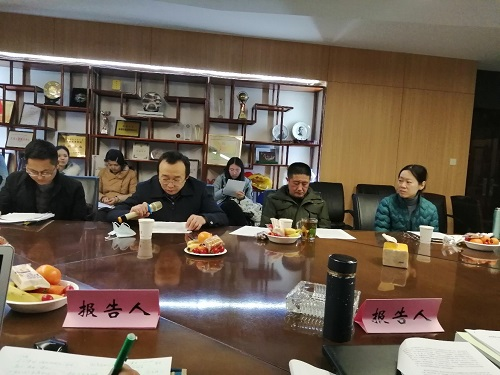The 25th Ph.D. Lectures, hosted by the School of History and Center for History of the Republic of China, Nanjing University, was held as scheduled in 223 conference room of the School of History, started at 18:30 on December 18, 2020.
Teachers Luo Xiaoxiang, Li Yu, and Temule and over 30 graduate students attended the lecture.
This lecture was presided over by Wen Tianpeng, a 2019 doctoral student in Modern Chinese History (i.e., entering the program in 2019).
The first speaker was Sa Haitao, a 2020 doctoral student in Ancient Chinese History. The title was "Integration of Islam with Confucian Orthodoxy Theory——Pangu and Fuxi in related Chinese Islamic Literature in the Ming and Qing Dynasties." Based on the related Islamic literature in Chinese in the Ming and Qing Dynasties, the speaker explored the reasons why the Hui scholars introduced the two humanistic ancestors of ancient Chinese legends Pangu and Fuxi into the Islamic orthodox pedigree, and their role in the integration of Islam with Confucianism.

After the presentation, the 2019 doctoral student Liang Wenli and the 2020 doctoral student Xu Ziming made their comments, respectively.
Liang Wenli held that the paper had abundant historical materials and a clear structure and discussion and it has kept up with the current hot topics. At the same time, he also pointed out that it was a little rough in its discussion on the relationship between Judaism and Islam. The fourth section of the presentation, which echoed the overall theme, seemed thin in relation to the volume of the whole paper.
Xu Ziming first questioned the break in the genealogy of Yavoxi’s transmission, and then wondered whether the theme of the paper, the "integration of Islam with Confucianism," was a farfetched comparison. He suggested that when observing the exchange between Chinese culture and Islamic civilization, a "dynamic" perspective may be more in line with the original meaning of history than a "static" perspective.
Teachers from the School of History, Li Yu, Luo Xiaoxiang and Temule joined the discussion.
Li Yu held that the topic was novel and had a large academic space. At the same time, he also pointed out that the paper needs to do some meticulous work in terms of questioning and textual research, and the integration of Confucian orthodoxy theory deserves more in-depth ideological discussions.
Luo Xiaoxiang mainly questioned the purpose of translation, rewriting, and reference by Islamic scholars.
Temule pointed out that the academic research on "Islam and Confucianism" has started since 2002, but the historical materials of other ethnic groups have been ignored by scholars in China. He thus hoped that the speaker could pay attention to those materials. He also asked whether the so-called integration of Islam with Confucianism had any missionary purposes.
The second speaker was Zhu Defeng, a 2019 doctoral student in Modern Chinese History. His topic was "The Quantity and Quality of Cultural Invasion: An Analysis of the Activities of Modern Japanese Shin Buddhism in Northeast China." He started from empirical research, and on the basis of the extensive use of Chinese and Japanese archives, he attempted to study and restore the activities of Japanese Shin Buddhism in modern Northeastern China by quantitative and qualitative methods. He found that the "cultural invasion" paradigm can better explain and understand the truth of cultural activities of modern expatriate religious figures in China and their missionary activities.

After the presentation, 2019 doctoral students Tong Jiaran and Chen Zhen in Modern Chinese History made their comments.
Tong Jiaran held that the speaker dared to question the established research paradigm and used a lot of Japanese original materials. However, the speaker’s attitude towards "cultural invasion" was very ambiguous, and the relationship between the activities of Shin Buddhism in Northeastern China and the Japanese government was not shown in the relevant archives.
Chen Zhen commented that the speaker has done a good job in historical data sorting and the use of tables also gave a visual impression. However, there are few dialogues between the presentation and the existing research, the viewpoint is not clear, and the topic is slightly too general.
Then, Teachers Temule, Li Yu and Luo Xiaoxiang made their comments. Temule held that the scope of the paper could be broadened and that the geological area should not be limited to the Northeast, and that the upper and lower limits of time might also be adjusted.
Li Yu first affirmed the speaker’s detailed comments and good selection of the topic. At the same time, he pointed out that the paper is not very clear, so the content of the Shin Buddhism activities in the Northeast can be more specific.
Luo Xiaoxiang said that the speaker did not discuss the criteria for "cultural invasion" in depth and that the identification of converts and the specific situations of the missionaries to China could be further explored.

The two speakers responded to the questions raised by the teachers and fellow students. In the free discussion session, several students exchanged their relevant research and reading experience with the speakers.
Finally, the academic lecture activity was successfully concluded with warm applauses.
(Article written by Yang Jie and Yang Shanghua of the Secretariat, and photos taken by Liu Yongxue)

